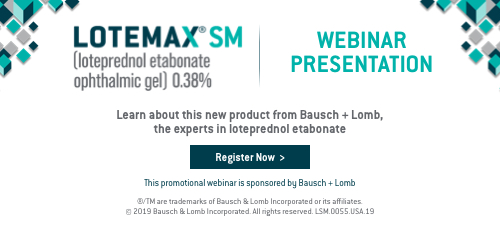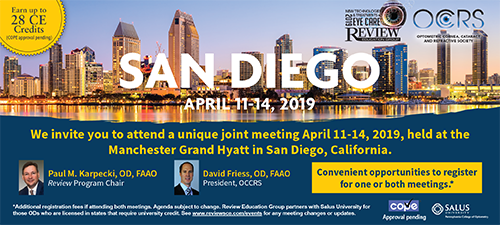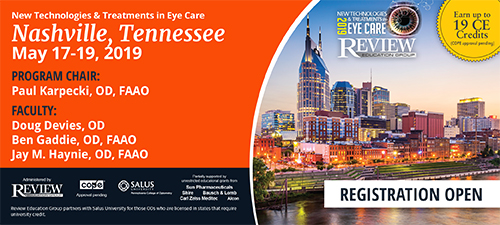
A
weekly e-journal by Art Epstein, OD, FAAO
Off the Cuff: The Other Shoe
Many patients seen in optometric practice initially present complaining of visual problems. Most are refractive in nature. For children and teens, myopia or astigmatism usually prompt the visits. For adults, the most common reason for an exam is the onset of presbyopia. Yes, I realize that a good number of 20/happy patients will simply purchase “readers” from their local Wal-Mart or Walgreens, but most will at some point come in for an eye exam. If you don’t believe that presbyopes make up a significant percentage of your new and existing patients, review your exam records for the past few weeks and you’ll undoubtedly see how important presbyopia is as an entry point for eye care. PRX100 from Presbyopia Therapies is a once-daily drop approaching Phase III clinical trials. Novartis has UNR844 (formerly EV06) acquired when it purchased Encore Vision in 2017. Early clinical trials for EV06 were quite favorable—enough for Novartis to buy Encore Vision for $465 million. Allergan is developing AGN-190584 and AGN-199201. Orasis Pharmaceuticals is currently in Phase II trials of its CSF-1. Other presbyopia drugs are in various stages of development. Based on currently available information, most appear safe and effective. When these drugs will be approved by the FDA is still unknown, but considering how huge the presbyopia drug market is likely to be, sooner is more likely than later. The bigger question for us is whether these drugs will be Rx-only or OTC, as I suspect most companies would much prefer the latter. From a future-of-the-profession perspective, perhaps it’s time to seriously start thinking about the impact these new drugs will have on patients and your practice.
|
|||||
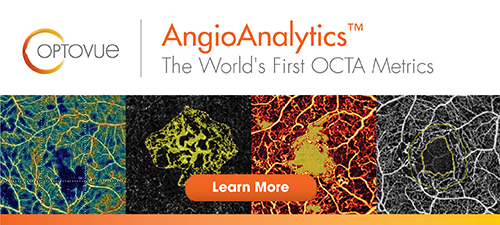 |
||
| Corneal Surface Wettability and Tear Film Stability Before and After Scleral Lens Wear | ||||
The aim of this study was to evaluate the anterior surface of scleral contact lens and ocular surface wettability before and after one-month of scleral lens wear in patients with keratoconus. Forty-nine patients with keratoconus (36.26 ± 9.03 years) were recruited. The sample was divided into two groups: patients with intrastromal corneal ring (KCICRS group) and patients without ICRS (KC group). TFSQ, Schirmer I test, Ocular Surface Disease Index (OSDI questionnaire), tear break-up time (TBUT) and corneal staining were evaluated in two different visits: baseline (before lens wear) and one-month visit (10 minutes after lens removal). Visual Analog Scale (VAS questionnaire) was filled in just after inserting the lenses and just before removing them. TFSQ mean and inferior were evaluated over the contact lens surface at the moment of inserting the lens (baseline visit) and after eight hours of lens wear (one-month visit).
Anterior corneal surface TFSQ values increased in all groups after scleral lens wear. However, there were no statistical differences found at the moment of inserting or after eight hours of lens wear on previous contact lens surface TFSQ. No changes were found in tear volume for total and in KC and KCICRS groups. For all groups, there was a statistical decrease of TBUT. In addition, OSDI score, corneal staining and VAS score improved after scleral lens wear from baseline in total, and in both KC and KCICRS groups. Researchers found that the scleral contact lens surface kept its wettability after one month of wear. However, they determined that the wettability of the ocular surface was worse after contact lens wearing. |
||||
SOURCE: Serramito M, Privado-Aroco A, Batres L, Carracedo G. Corneal surface wettability and tear film stability before and after scleral lens wear. Cont Lens Anterior Eye. 2019; Apr 6. [Epub ahead of print]. |
||||
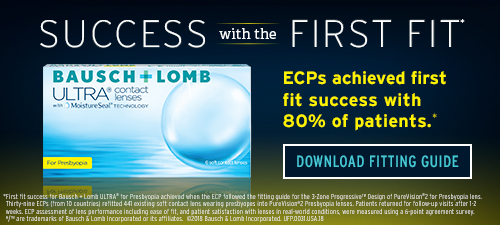 |
||
| Real-life Evidence for Using a Treat-and-extend Injection Regime for Patients with Central Retinal Vein Occlusion | ||||
A retrospective analysis of patients newly diagnosed with central retinal vein occlusion (CRVO) was performed to report the 52-week treatment outcomes with intravitreal injections of aflibercept using a treat-and-extend regimen for treating macular edema secondary to CRVO. Patients receiving aflibercept between Dec. 1, 2016, and March 31, 2017, were included in the analysis. Data on age, gender, visual acuity measured on Early Treatment of Diabetic Retinopathy Study charts, presence of macular and peripheral ischemia, anatomical changes observed on spectral domain-optical coherence tomography examination and the number of injections needed were recorded.
The mean gain in vision was 17.8 ± 19.1 (± standard deviation) letters and 15.1 ± 20.2 letters at weeks 24 and 52 of follow-up, respectively. The proportion of patients who gained ≥15 letters in best-corrected visual acuity was 52.9% at week 24 and 50% at week 52. The mean reduction in central subfield macular thickness was 331.5 and 311.6 at weeks 24 and week 52, respectively. For the patients completing 52 weeks of follow-up, the mean number of treatments was 4.9 ± 1.3 injections in the first 26 weeks and 3.2 ± 2.0 injections in the second 26 weeks. Investigators wrote that the Moorfields protocol for treating macula edema in CRVO achieved a quick response to treatment without over- or undertreating patients with a fixed protocol. Overall, the individualized treat-and-extend protocol achieved real-life outcomes approaching those of clinical trials. As there are currently no such trials using this practically useful regimen, investigators suggested that the study provided real-world evidence for using a treat-and-extend protocol for aflibercept in CRVO. |
||||
SOURCE: Eleftheriadou M, Nicholson L, D'Alonzo G, et al. Real-life evidence for using a treat-and-extend injection regime for patients with central retinal vein occlusion. Ophthalmol Ther. 2019; Apr 10. [Epub ahead of print]. |
||||
 |
||
| Epiretinal Membrane in Eyes with Vitreomacular Traction | ||||
In this retrospective, observational, cross-sectional study, researchers collected data from 502 eyes (307 patients) with diagnoses of vitreomacular traction to describe the occurrence of epiretinal membrane (ERM) in eyes with vitreomacular traction and to correlate the presence of ERM with retinal structural alterations detected using spectral-domain optical coherence tomography. The presence of ERM and retinal lesions (cystoid cavities, neuroepithelial detachment, external limiting membrane and ellipsoid zone discontinuity) was determined by standardized grading of macular spectral-domain optical coherence tomography scans. The occurrence of ERM in eyes with vitreomacular traction was 37.5%. The mean ± SD central foveal thickness was 411 ± 60 µm in eyes with ERM and 380 ± 148 µm in eyes without ERM. The occurrence of cystoid cavities (38.3% vs. 23.2%), neuroepithelial detachment (24.5% vs. 9.9%), external limiting membrane discontinuity (16.5% vs. 5.1%) and ellipsoid zone discontinuity (13.3% vs. 6.7%) was higher in eyes with ERM. The mean ± SD best-corrected visual acuity was 0.45 ± 0.16 logarithm of the minimum angle of resolution (Snellen equivalent of approximately 20/50) in eyes with ERM and 0.37 ± 0.09 in eyes without ERM (Snellen equivalent of approximately 20/40). Symptoms of metamorphopsia were present in 55 of 188 eyes with ERM (29.3%) and 40 of 314 eyes without ERM (12.7%). This study reported the occurrence of ERM in eyes with vitreomacular traction and demonstrated that ERM is significantly associated with an increased occurrence of other structural changes of the neuroretina and a negative effect on quantity and quality of vision. |
||||
SOURCE: Carpineto P, Ciciarelli V, Borrelli E, et al. Epiretinal membrane in eyes with vitreomacular traction. Retina. 2019; Apr 4. [Epub ahead of print]. |
||||
| News & Notes | ||||||||
| Academy 2019 Orlando & 3rd World Congress of Optometry Education Program Announced The World Council of Optometry and the American Academy of Optometry are partnering to present Academy 2019 Orlando and the 3rd World Congress of Optometry (Oct. 23-27). This year’s Plenary Session is titled “Today’s Research, Tomorrow’s Practice: WHO World Report on Vision, Opportunities for Optometry to Make an Impact,” and will discuss the World Report on Vision on the distribution of eye disease and blindness across the globe, and the disease burden these eye conditions pose on nations and regions. Speakers will include Kovin Naidoo, OD, PhD, FAAO; Sandra Block, OD, MPH, FAAO; and a World Health Organization speaker. The Monroe J. Hirsch Research Symposium is titled “Gene Therapy for Ocular and Neurologic Disorders.” Speakers will include Stephen Russell, MD; Abbott Clark, PhD; and Byron Lam, MD. The Ezell Fellows Present symposium, titled “Public Health / Epidemiology Potpourri,” marks the 10th anniversary of the symposium. Read more. |
||||||||
| 2019 ARVO Student Travel Fellowship Recipients Announced The American Academy of Optometry named the recipients of the 2019 Student Travel Fellowship Awards. The travel fellowships, supported by Johnson and Johnson Vision Care, will enable five students to present their research at the Association for Research in Vision and Ophthalmology 2019 annual meeting. The 2019 recipients and their respective schools are: • Suman Adhikari, BOptom, University of Houston • Moonjung Choi, MS, Indiana University • Justin Courson, University of Houston • Nicole Karson, University of Houston • Natalie Stepien-Bernabe, University of California, Berkeley Applications for student travel fellowships for Academy 2019 Orlando and the 3rd World Congress of Optometry will be available in July 2019. Learn more.
|
||||||||
| J&J Vision’s Investigational Antihistamine-releasing CLs Demonstrate Positive Phase III Results Johnson & Johnson Vision announced that the results from two Phase III clinical studies evaluating the company’s investigational antihistamine-releasing contact lens (etafilcon A with 0.019 mg ketotifen) demonstrated that patients wearing the lens had lower mean itching scores after their eyes were exposed to allergens compared with those wearing non-medicated control lenses. The antihistamine-releasing contact lenses in the studies, published in Cornea, were daily disposable lenses containing ketotifen, a drug that inhibits certain substances known to cause allergic reactions and inflammation. They were tested in two multicenter, double-masked, randomized, placebo-controlled trials that included 244 patients and used the conjunctival allergen challenge model (Ora-CAC) to measure efficacy. Read more. |
||||||||
| Student/Resident Grants Available to Attend Nora Conference The Neuro-Optometric Rehabilitation Association, International is offering up to 10 students and residents with an interest in neuro-rehabilitation an opportunity to apply for a student grant to attend the organization’s Clinical Skills Pre-Conference (Sept.19 to 20) and 28th annual General Conference (Sept. 21 to 22) at the Embassy Suites by Hilton Scottsdale Resorts, Scottsdale, Ariz. Each grant recipient will receive full conference registration and $400 in travel grant funds. Vivid Vision, a virtual reality software manufacturer, is providing some support for the program through a $1,000 donation. Learn more. |
||||||||
| Avedro Reaches Reimbursement Milestone Avedro, announced that four new providers—Providence Health Plan in the Pacific Northwest, Health New England, HealthPartners Minnesota and Public Employees Health Plan in Utah—issued positive coverage policies for Avedro’s FDA-approved corneal cross-linking procedure. This brings the total number of commercial plans covering the KXL system and its associated Photrexa drug formulations to more than 65. Read more. |
||||||||
| Allegro Appoints Carlson and Colbert to Board Allegro Ophthalmics announced that two new independent members—Marc Carlson and Rebecca Colbert—were appointed to the company's board of directors, with Colbert serving as chairperson of the board's Audit Committee. Carlson brings more than 35 years of experience commercializing products in various industries. Formerly, as chief customer officer of DocuSign, he helped to grow DocuSign from a $50 million private company to a public company with a nearly $10 billion market capitalization. Colbert is chief financial officer at Vertos Medical, and has more than 15 years of experience working in senior level positions for medical device companies. She served as vice president of customer and sales operations at Bausch + Lomb U.S. Surgical, and as vice president of finance at eyeonics, where she played a significant role in the company's initial public offering and sale to Bausch + Lomb. Read more. |
||||||||
| Alcon Debuts as Independent, Publicly Traded Company Alcon, the global leader in eye care dedicated to helping people see brilliantly, today announced its debut as an independent, publicly traded company and the completion of its separation from Novartis. The company’s shares begin trading today on the SIX Swiss Exchange and New York Stock Exchange (NYSE) under the symbol “ALC.” Alcon is the largest eye care device company in the world, with complementary businesses in Surgical and Vision Care. The company has a global presence in 74 countries and serves patients in more than 140, with fast-growing businesses in emerging markets. Alcon has the widest array of eye care offerings in the industry with products that can treat eye disorders at each stage of life. Read more. |
||||||||
| Alimera Appoints Dr. Kaba MD as CMO
Alimera Sciences appointed Samer Kaba, MD, as chief medical officer, a new position at the company, effective April 4. Dr. Kaba is a board-certified neurologist with more than 15 years of pharmaceutical industry experience leading diverse teams and global projects. Prior to joining Alimera, Dr. Kaba served as chief medical officer at Cortexyme, and global head of clinical development and medical affairs at Osmotica Pharmaceuticals. Previous to that, as vice president of medical affairs at Medpace, Dr. Kaba was instrumental in expanding claims and messaging in the neuroscience therapeutic area. Dr. Kaba held several academic positions prior to working in the pharmaceutical industry. Read more. |
||||||||
|
||||||||
|
||||||||
|
Optometric Physician™ (OP) newsletter is owned and published by Dr. Arthur Epstein. It is distributed by the Review Group, a Division of Jobson Medical Information LLC (JMI), 11 Campus Boulevard, Newtown Square, PA 19073. HOW TO ADVERTISE |


